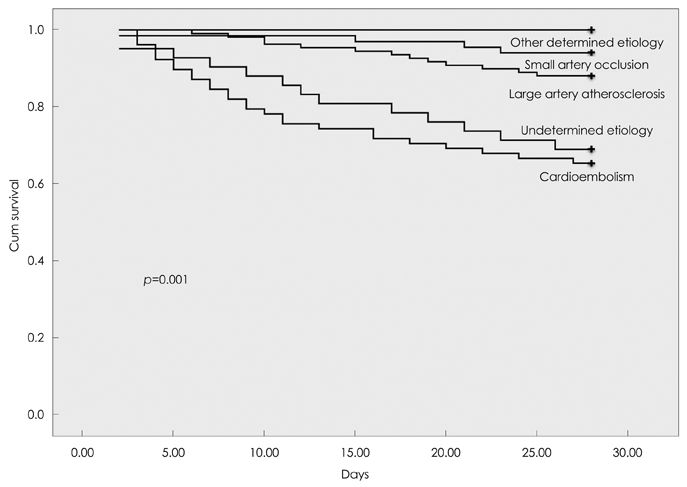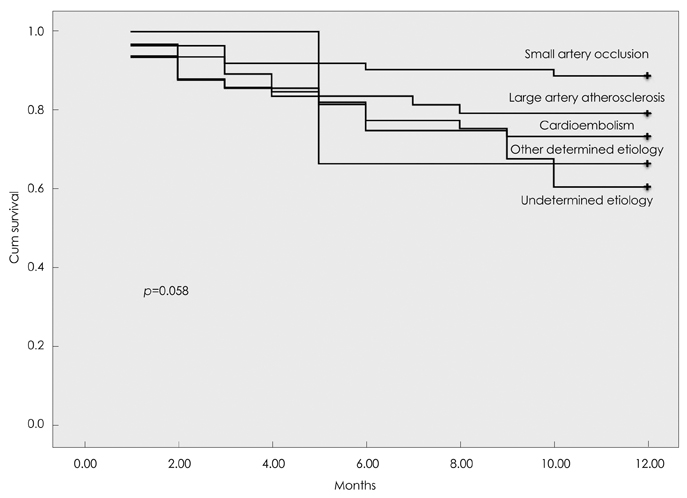J Clin Neurol.
2013 Jan;9(1):14-20. 10.3988/jcn.2013.9.1.14.
Short-Term and Long-Term Stroke Survival: The Belgrade Prognostic Study
- Affiliations
-
- 1Department of Neurology, Clinical Center Dr Dragisa Misovic, Belgrade, Serbia.
- 2Department of Emergency Neurology, Clinic of Neurology, Clinical Center of Serbia, Faculty of Medicine, University of Belgrade, Belgrade, Serbia.
- 3Institute of Epidemiology, Faculty of Medicine, University of Belgrade, Belgrade, Serbia. pekmezovic@sezampro.rs
- KMID: 2287565
- DOI: http://doi.org/10.3988/jcn.2013.9.1.14
Abstract
- BACKGROUND AND PURPOSE
The aims of this study were to determine the 28-day and 1-year survival rates after first-ever ischemic stroke and to identify their baseline predictors.
METHODS
We prospectively and consecutively collected data on 300 patients with first-ever acute ischemic stroke admitted to 2 major neurological institutions for cerebrovascular diseases in Belgrade during March 2008. The Kaplan-Meier method was used to estimate the cumulative 28-day and 1-year survival rates, and the predictive values of different variables were assessed by Cox proportional-hazards regression model.
RESULTS
The cumulative 28-day and 1-year survival rates of ischemic stroke patients in the cohort were 81.0% and 78.3%, respectively. The multivariate predictive model revealed that hypertension (p=0.017), National Institutes of Health Stroke Scale score (p=0.001), and in-hospital medical complications (p=0.029) were significant unfavorable independent outcome predictors, while early physical therapy (p=0.001) was a significant favorable prognostic factor for the 28-day mortality in our patients. Multivariate Cox regression analysis showed that age (p=0.001), National Institutes of Health Stroke Scale score (p=0.001), and in-hospital complications (p=0.008) remained significant predictors of 1-year mortality.
CONCLUSIONS
The findings support the need for optimal control of vascular risk factors and treatment of atherosclerotic disease as well as appropriate prevention and management of in-hospital complications of stroke.
MeSH Terms
Figure
Reference
-
1. Pekmezovic T, Vlajinac H, Sipetic-Grujicic S, Kocev N, Tepavcevic DK, Bumbasirevic LB. Preedy VR, Watson RR, editors. Burden of cerebrovascular diseases (stroke) in Serbia. Handbook of Disease Burdens and Quality of Life Measures. 2010. New York: Springer;950–964.
Article2. Pekmezovic T, Tepavcevic DK, Jarebinski M, Kostic M, Bumbasirevic L. Stroke mortality in Belgrade, Serbia: age, period, and cohort analyses. Cerebrovasc Dis. 2007. 24:191–195.3. Pekmezovic T, Tepavcevic DK, Jarebinski M, Kostic M, Bumbasirevic L. Trends in mortality from different subtypes of stroke in the population of Belgrade (Serbia). Clin Neurol Neurosurg. 2008. 110:51–57.
Article4. Johnston SC, Mendis S, Mathers CD. Global variation in stroke burden and mortality: estimates from monitoring, surveillance, and modelling. Lancet Neurol. 2009. 8:345–354.
Article5. Endres M, Heuschmann PU, Laufs U, Hakim AM. Primary prevention of stroke: blood pressure, lipids, and heart failure. Eur Heart J. 2011. 32:545–552.
Article6. Olsen TS. Fisher M, editor. Stroke recurrence and prognosis after stroke. Handbook of Clinical Neurology. 2009. 92. New York: Elsevier;406–421.7. Kolominsky-Rabas PL, Weber M, Gefeller O, Neundoerfer B, Heuschmann PU. Epidemiology of ischemic stroke subtypes according to TOAST criteria: incidence, recurrence, and long-term survival in ischemic stroke subtypes: a population-based study. Stroke. 2001. 32:2735–2740.
Article8. Adams HP Jr, Bendixen BH, Kappelle LJ, Biller J, Love BB, Gordon DL, et al. Classification of subtype of acute ischemic stroke. Definitions for use in a multicenter clinical trial. TOAST. Trial of Org 10172 in Acute Stroke Treatment. Stroke. 1993. 24:35–41.
Article9. Counsell C, Dennis M. Systematic review of prognostic models in patients with acute stroke. Cerebrovasc Dis. 2001. 12:159–170.
Article10. Hakkennes SJ, Brock K, Hill KD. Selection for inpatient rehabilitation after acute stroke: a systematic review of the literature. Arch Phys Med Rehabil. 2011. 92:2057–2070.
Article11. Koton S, Tanne D, Green MS, Bornstein NM. Mortality and predictors of death 1 month and 3 years after first-ever ischemic stroke: data from the first national acute stroke Israeli survey (NASIS 2004). Neuroepidemiology. 2010. 34:90–96.
Article12. Saposnik G, Hill MD, O'Donnell M, Fang J, Hachinski V, Kapral MK, et al. Variables associated with 7-day, 30-day, and 1-year fatality after ischemic stroke. Stroke. 2008. 39:2318–2324.
Article13. Andersen KK, Andersen ZJ, Olsen TS. Predictors of early and late case-fatality in a nationwide Danish study of 26,818 patients with first-ever ischemic stroke. Stroke. 2011. 42:2806–2812.
Article14. Appelros P, Nydevik I, Viitanen M. Poor outcome after first-ever stroke: predictors for death, dependency, and recurrent stroke within the first year. Stroke. 2003. 34:122–126.15. Vemmos KN, Bots ML, Tsibouris PK, Zis VP, Takis CE, Grobbee DE, et al. Prognosis of stroke in the south of Greece: 1 year mortality, functional outcome and its determinants: the Arcadia Stroke Registry. J Neurol Neurosurg Psychiatry. 2000. 69:595–600.
Article16. Goldstein LB, Bertels C, Davis JN. Interrater reliability of the NIH stroke scale. Arch Neurol. 1989. 46:660–662.
Article17. van Swieten JC, Koudstaal PJ, Visser MC, Schouten HJ, van Gijn J. Interobserver agreement for the assessment of handicap in stroke patients. Stroke. 1988. 19:604–607.
Article18. Bae HJ, Yoon DS, Lee J, Kim BK, Koo JS, Kwon O, et al. In-hospital medical complications and long-term mortality after ischemic stroke. Stroke. 2005. 36:2441–2445.
Article19. Katzenellenbogen JM, Vos T, Somerford P, Begg S, Semmens JB, Codde JP. Excess mortality rates for estimating the non-fatal burden of stroke in Western Australia: a data linkage study. Cerebrovasc Dis. 2010. 30:57–64.
Article20. Kwan J, Hand P, Sandercock P. A systematic review of barriers to delivery of thrombolysis for acute stroke. Age Ageing. 2004. 33:116–121.
Article21. Bejot Y, Caillier M, Ben Salem D, Couvreur G, Rouaud O, Osseby GV, et al. Ischaemic stroke subtypes and associated risk factors: a French population based study. J Neurol Neurosurg Psychiatry. 2008. 79:1344–1348.
Article22. Stead LG, Gilmore RM, Bellolio MF, Jain A, Rabinstein AA, Decker WW, et al. Cardioembolic but not other stroke subtypes predict mortality independent of stroke severity at presentation. Stroke Res Treat. 2011. 2011:281496.
Article23. Kumar S, Selim MH, Caplan LR. Medical complications after stroke. Lancet Neurol. 2010. 9:105–118.
Article24. Langhorne P, Stott DJ, Robertson L, MacDonald J, Jones L, McAlpine C, et al. Medical complications after stroke: a multicenter study. Stroke. 2000. 31:1223–1229.25. Appelros P, Nydevik I, Seiger A, Terént A. Predictors of severe stroke: influence of preexisting dementia and cardiac disorders. Stroke. 2002. 33:2357–2362.26. Diserens K, Michel P, Bogousslavsky J. Early mobilisation after stroke: Review of the literature. Cerebrovasc Dis. 2006. 22:183–190.
Article27. Quinn TJ, Paolucci S, Sunnerhagen KS, Sivenius J, Walker MF, Toni D, et al. Evidence-based stroke rehabilitation: an expanded guidance document from the European stroke organization (ESO) guidelines for management of ischaemic stroke and transient ischaemic attack 2008. J Rehabil Med. 2009. 41:99–111.
Article28. Kammersgaard LP, Jørgensen HS, Reith J, Nakayama H, Pedersen PM, Olsen TS, et al. Short- and long-term prognosis for very old stroke patients. The Copenhagen Stroke Study. Age Ageing. 2004. 33:149–154.
Article
- Full Text Links
- Actions
-
Cited
- CITED
-
- Close
- Share
- Similar articles
-
- Prognosis and Prognostic Factors of Caudate Hemorrhage
- Epidemiology, Natural Recovery, Long-term Outcome of Post Stroke Dysphagia
- Association between Levetiracetam Use and Survival in Patients with Glioblastoma: A Nationwide Population-Based Study
- Analysis of Long-Term Survivors after Resection for Hilar Bile Duct Cancer
- Long-term follow-up study and long-term care of childhood cancer survivors



